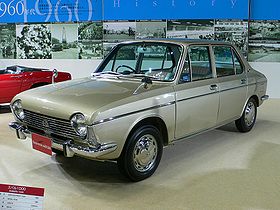Subaru 1000
| Subaru 1000 | |
|---|---|

Subaru 1000 sedan
|
|
| Overview | |
| Manufacturer | Subaru (Fuji Heavy Industries) |
| Production | 1966–1969 |
| Assembly | Yajima Plant, Ota, Gunma, japan |
| Designer | Shinroku Momose |
| Body and chassis | |
| Body style | 2-door sedan 4-door sedan 2- and four-door station wagon |
| Layout | FF layout |
| Powertrain | |
| Engine | 977 cc F4, 55 hp (41 kW) |
| Dimensions | |
| Wheelbase | 2,420 mm (95.3 in) |
| Length | 3,930 mm (154.7 in) |
| Width | 1,480 mm (58.3 in) |
| Height | 1,390 mm (54.7 in) |
| Curb weight | 670–695 kg (1,477–1,532 lb) |
| Chronology | |
| Predecessor | Subaru 1500 |
| Successor | Subaru Leone |
| Subaru FF-1 1300G | |
|---|---|

Subaru 1300G Sports Sedan
|
|
| Overview | |
| Manufacturer | Subaru (Fuji Heavy Industries) |
| Also called | Subaru 1300G, FF-1 G |
| Production | 1971-1972 |
| Designer | Shinroku Momose |
| Body and chassis | |
| Class | Subcompact |
| Body style | 2-door Sedan 4-door Sedan 5-door wagon |
| Layout | Front-engine Front Wheel Drive Front-engine Four Wheel Drive |
| Powertrain | |
| Engine | 1.1L/1.3L Subaru EA engine |
| Transmission | Four Speed Manual |
| Dimensions | |
| Wheelbase | 2,431 mm (95.7 in) |
| Length | 3,937 mm (155.0 in) |
| Width | 1,481 mm (58.3 in) |
| Height | 1,389 mm (54.7 in) |
| Curb weight | 662 kg (1,460 lb) |
| Chronology | |
| Successor | Subaru Leone |
The Subaru 1000 was the first front wheel drive Subaru produced by Fuji Heavy Industries that was in the Japanese government "compact car" classification starting in 1966. Previous Subaru models such as the Subaru 360 and the Sambar had been rear-engined, rear wheel drive kei cars.
It was the first production Subaru to use a boxer engine.
In 1960, Subaru management decided to introduce a successor to the prototype Subaru 1500 with a new code name A-5 with a four-cycle air-cooled horizontally opposed four-cylinder engine displacing 1500 cc, driving the front wheels in a compact car platform. It was to have a double wishbone front suspension. Due to FHI's limited resources, the car was not produced. The Subaru 360 was selling at the time but Subaru wanted a car that could comfortably carry four passengers without a cramped compartment, that would appear to be an alternative to the Toyota Corolla, Nissan Sunny, Mazda Familia, Hino Contessa, Isuzu Bellett, and the Mitsubishi Colt 1000. Subaru also wanted to reduce engine noise by placing the engine at the front and improve interior space by implementing front wheel drive, thereby eliminating a centrally mounted drive shaft powering the rear wheels, and utilizing an independent suspension at all four wheels. The only other Japanese company to use an air-cooled, horizontally opposed engine at the time was in the Publica, and the Toyota U engine.
In 1963, Subaru tried again, with a new project code A-4, with a smaller 923 cc engine, front wheel drive, and an overall length of 3,885 mm (153.0 in), a wheelbase of 2,400 mm (94 in), a front wheel width of 1,230 mm (48 in) and a rear wheel width of 1,220 mm (48 in), weighing 500 kg (1,100 lb). The model was put into production; it was assigned production code A-63 and was eventually introduced as the Subaru 1000. For compactness and to ensure quietness of operation with vibration kept to a minimum, the engine was developed with water cooling instead of the originally intended air cooling in the A-5 concept.
...
Wikipedia
